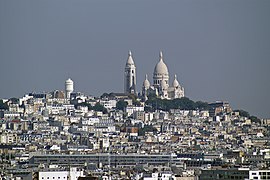18th arrondissement of Paris
Municipal arrondissement in Île-de-France, France From Wikipedia, the free encyclopedia
Municipal arrondissement in Île-de-France, France From Wikipedia, the free encyclopedia
Seamless Wikipedia browsing. On steroids.
Every time you click a link to Wikipedia, Wiktionary or Wikiquote in your browser's search results, it will show the modern Wikiwand interface.
Wikiwand extension is a five stars, simple, with minimum permission required to keep your browsing private, safe and transparent.
The 18th arrondissement of Paris (XVIIIe arrondissement) is one of the 20 arrondissements, or administrative districts, of the capital city of France. In spoken French, this arrondissement is referred to as dix-huitième.
18th arrondissement of Paris | |
|---|---|
 View over Montmartre district | |
 Location within Paris | |
| Coordinates: 48°53′32″N 2°20′40″E | |
| Country | France |
| Region | Île-de-France |
| Department | Paris |
| Commune | Paris |
| Government | |
| • Mayor (2020–2026) | Éric Lejoindre (PS) |
| Area | 6.01 km2 (2.32 sq mi) |
| Population (2021)[1] | 188,446 |
| • Density | 31,355/km2 (81,210/sq mi) |
| INSEE code | 75118 |
The arrondissement, known as Butte-Montmartre, is located on the right bank of the River Seine. It is mostly known for hosting the large hill of Montmartre, which is known for its artistic history, the Bateau-Lavoir where Pablo Picasso, Georges Braque, and Amedeo Modigliani lived and worked in the early 20th century,[2] the house of music diva Dalida, the Moulin Rouge cabaret, other historic features, and the prominent Sacré Cœur basilica which sits atop the hill.
The 18th arrondissement also contains Goutte d'Or district, which has large numbers of residents of North and sub-Saharan African origins, and which is famous for its market, the marché Barbès, which sells products from Africa.
The land area of this arrondissement is exactly 6.005 km2 (2.319 sq mi; 1,484 acres).
The population of Paris's 18th arrondissement peaked in 1931 with 288,810 inhabitants. Today, the arrondissement remains very dense in population and business activity with 200,631 inhabitants as of the most recent census (2009).
| Year (of French censuses) |
Population | Density (inh. per km2) |
|---|---|---|
| 1872 | 138,109 | 22,980 |
| 1931 (peak of population) | 288,810 | 48,095 |
| 1954 | 266,825 | 44,397 |
| 1962 | 254,974 | 42,460 |
| 1968 | 236,776 | 39,430 |
| 1975 | 208,970 | 34,799 |
| 1982 | 186,866 | 31,118 |
| 1990 | 187,657 | 31,250 |
| 1999 | 184,586 | 30,739 |
| 2009 | 200,631 | 33,383 |
In 2012, John Henley of The Guardian said the 18th arrondissement was "an area comparable in many ways to London's Tower Hamlets."[3]
| Born in metropolitan France | Born outside metropolitan France | |||
|---|---|---|---|---|
| 72.5% | 27.5% | |||
| Born in overseas France |
Born in foreign countries with French citizenship at birth1 | EU-15 immigrants2 | Non-EU-15 immigrants | |
| 1.9% | 3.6% | 3.9% | 18.1% | |
| 1 This group is made up largely of former French settlers, such as pieds-noirs in Northwest Africa, followed by former colonial citizens who had French citizenship at birth (such as was often the case for the native elite in French colonies), as well as to a lesser extent foreign-born children of French expatriates. A foreign country is understood as a country not part of France in 1999, so a person born for example in 1950 in Algeria, when Algeria was an integral part of France, is nonetheless listed as a person born in a foreign country in French statistics. 2 An immigrant is a person born in a foreign country not having French citizenship at birth. An immigrant may have acquired French citizenship since moving to France, but is still considered an immigrant in French statistics. On the other hand, persons born in France with foreign citizenship (the children of immigrants) are not listed as immigrants. | ||||
The Serbian Orthodox Eparchy of Western Europe has its headquarters in the arrondissement.[4]
Dailymotion formerly had its headquarters in the arrondissement.[5] In addition, Dargaud also has its headquarters there.[6]